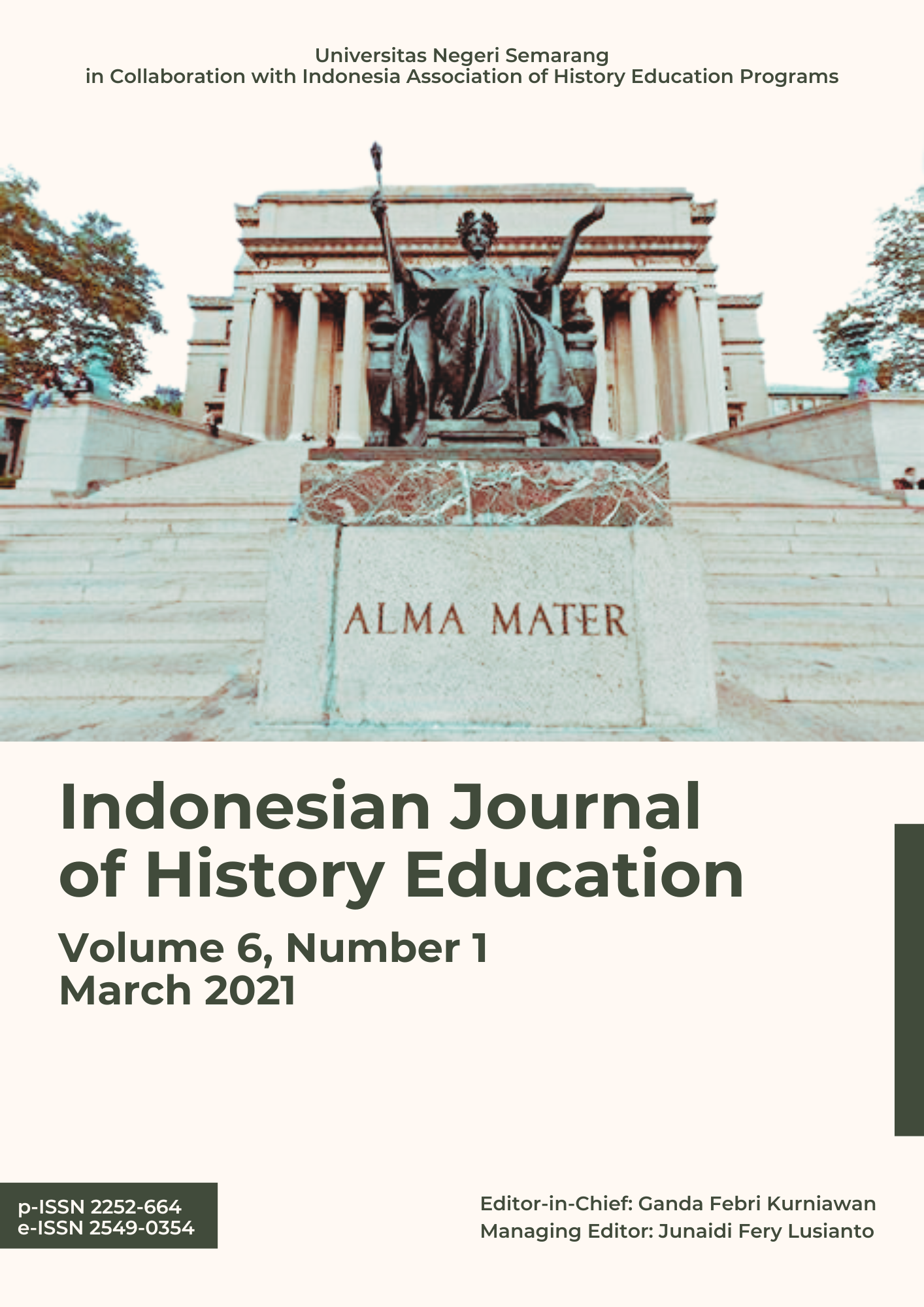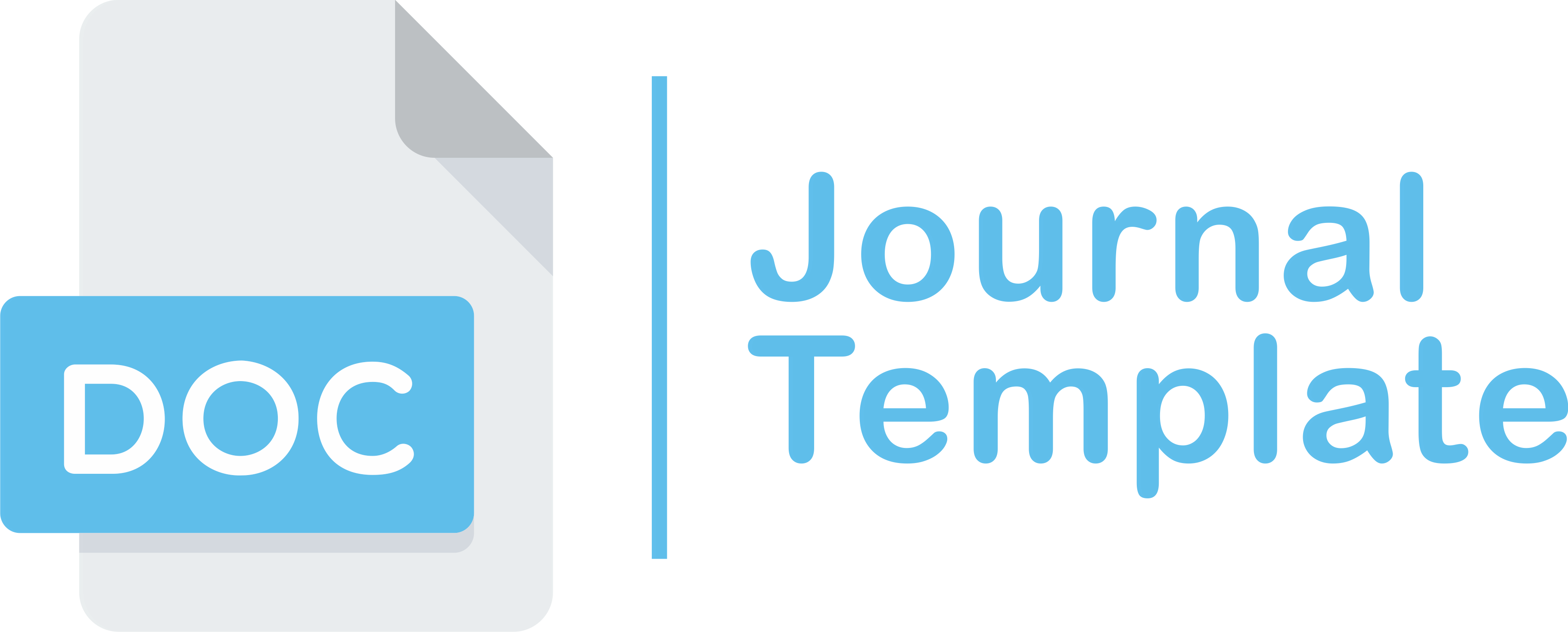The Effect of the Use of PowerPoint Media on the Interest in Learning History of Class X Students of SMA Negeri 1 Bumiayu
Abstract
This research aimed to find out the learning interest for the History Lessons of students in X class SMA Negeri 1 Bumiayu before and after using PowerPoint media and to find out the effect of PowerPoint media on learning interest in History lessons of Students at SMA Negeri 1 Bumiayu. This type of research was quantitative, using an experimental research method in the form of a pre-experimental design and a one-group pre-test post-test design. The research population was all students in X class SMA Negeri 1 Bumiayu selected using a random sampling technique. Data collection techniques included observation, questioning, documentation, and literature. The data analysis technique used descriptive and inferential analysis techniques. Based on the analysis results, the first test (pre-test) generated an average of 52%, and the second test (post-test) was 68%. Besides the average percentage interest score, the test - t also showed that the value of count -8.479, based on distribution table t, value table for df = 35 was 2.042, and significant values were 0.000 < 0.05. With the value of count < table, it can be concluded that Ha is accepted and Ho is rejected, which means using PowerPoint media affects students' learning interests at SMA Negeri 1 Bumiayu.
References
Amalia, I. A. (2016). Power point sebagai alternatif media pembelajaran masa kini. Edueksos Jurnal Pendidikan Sosial & Ekonomi, 3(2).
Atno, A. (2011). Efektivitas media CD interaktif dan media VCD terhadap hasil belajar sejarah siswa SMA Negeri di Banjarnegara ditinjau dari tingkat motivasi belajar. Paramita: Historical Studies Journal, 21(2).
Bancin, H. F. (2018). Upaya Meningkatkan Kemampuan Siswa dengan Menggunakan Model Pembelajaran Genius Learning dengan Bantuan Media PowerPoint Pada Pokok Bahasan Perkalian Dan Pembagian Bentuk Aljabar di Kelas VIII SMP N 1 Salak TA 2018/2019.
Budianto, A. A. T., & Katini, A. (2015). Pengaruh lingkungan kerja terhadap kinerja pegawai pada PT Perusahaan Gas Negara (PERSERO) Tbk SBU Distribusi wilayah I Jakarta. Jurnal Ilmiah Prodi Manajemen Universitas Pamulang, 3(1), 100-124.
Dewi, Y. A. (2019). Upaya Meningkatkan Minat Belajar Matematika Melalui Media Pembelajaran Berbantuan Komputer. Desimal: Jurnal Matematika, 2(3), 211-231.
Elpira, N., & Ghufron, A. (2015). Pengaruh penggunaan media powerpoint terhadap Minat dan hasil belajar ipa siswa kelas IV SD. Jurnal Inovasi Teknologi Pendidikan, 2(1), 94-104.
Fahyuni, E. F., & Istikomah, I. (2016). Psikologi Belajar & Mengajar (kunci sukses guru dalam interaksi edukatif).
Hidayat, H., dkk. (2013). Read Interest CoRelational With Student Study Performance In IPS Subject Grade IV (Four) In State Elementary School 1 Pagerwangi Lembang. Journal Of Scientific and Technology Research: Vol. 2, No. 1.
Hikmah, S. N., & Maskar, S. (2020). Pemanfaatan aplikasi microsoft powerpoint pada siswa smp kelas viii dalam pembelajaran koordinat kartesius. Jurnal Ilmiah Matematika Realistik, 1(1), 15-19.
Jakni, S. P. (2016). Metodologi penelitian eksperimen bidang pendidikan. Bandung: Alfabeta.
Jamilah, N. (2019). Pengembangan Media Pembelajaran Power Point Ispring Presenter Pada Materi Kosakata Bahasa Arab Peserta Didik Kelas V MI Tarbiyatul Athfal Lampung Timur. Al Mahāra: Jurnal Pendidikan Bahasa Arab, 5(1), 141-150.
Kahayun. (2015). Pengaruh Gallery Walk Terhadap Minat Belajar Sejarah DI SMA N 1 Natar. Jurnal FKIP Unila. Vol.5 No.2.
Munib, A. (2015). Pengantar Ilmu Pendidikan. Semarang: Universitas Negeri Semarang Press.
Mustari, M. (2015). Pengaruh penggunaan media gambar lewat komputer terhadap hasil belajar fisika pada siswa kelas X SMA Negeri 3 Makassar. Jurnal Ilmiah Pendidikan Fisika Al-Biruni, 4(2), 271-283.
Pramono, Eko S. (2012). Perbaikan Kesalahan Konsep Pembelajaran Sejarah. Jurnal Paramita. Vol. 22, No. 2.
Ratnasari, P. I., & Bypmyrr, Y. (2012). Pengetahuan pemustaka upt perpustakaan universitas diponegoro tentang undang-undang hak cipta. Jurnal Ilmu Perpustakaan, 1(1), 1-8.
Setyono, Y. A. (2012). Pengembangan media pembelajaran fisika berupa buletin dalam bentuk buku saku untuk pembelajaran fisika kelas VIII materi gaya ditinjau dari minat baca siswa.
Shalikhah, N. D. (2016). Pemanfaatan aplikasi Lectora Inspire sebagai media pembelajaran interaktif. Cakrawala: Jurnal Studi Islam, 11(1), 101-115.
Slameto. (2010). Belajar dan faktor-faktor yang mempengaruhinya. Jakarta: PT. Rineka Cipta.
Sugiyono. (2016). Metode Penelitian Pendidikan Pendekatan Kuantitatif, Kualitatif, dan R&D. Bandung: Alfabeta.
Suryadi, A. (2012). Pembelajaran Sejarah dan Problematikanya. Jurnal Historia Pedagogia: Vol. 1, No. 1.
Suryani, N. (2016). Utilization of Digital Media to Improve The Quality and Attractiveness of The Teaching of History. Journal International Conference On Teacher Training and Education (ICTTE) Sebelas Maret University. Vol. 2, No. 1.
Utomo, B., dkk. (2018). Wayang Suluh Sebagai Media Pembelajaran Sejarah di SMA. Jurnal Paramita. Vol. 28 No.1
Wijaya, M. S. P., Hidayat, R., & Rafida, T. (2019). Manajemen Sumberdaya Pendidik Dan Tenaga Kependidikan.
Copyright (c) 2021 Indonesian Journal of History Education

This work is licensed under a Creative Commons Attribution 4.0 International License.
Copyright Notice
An author who publishes in the Jurnal Indonesian Journal of History Education agrees to the following terms:
- Author retains the copyright and grants the journal the right of first publication of the work simultaneously licensed under the Creative Commons Attribution-ShareAlike 4.0 License that allows others to share the work with an acknowledgement of the work's authorship and initial publication in this journal
- Author is able to enter into separate, additional contractual arrangements for the non-exclusive distribution of the journal's published version of the work (e.g., post it to an institutional repository or publish it in a book) with the acknowledgement of its initial publication in this journal.
- Author is permitted and encouraged to post his/her work online (e.g., in institutional repositories or on their website) prior to and during the submission process, as it can lead to productive exchanges, as well as earlier and greater citation of the published work (See The Effect of Open Access).
Read more about the Creative Commons Attribution-ShareAlike 4.0 Licence here: https://creativecommons.org/licenses/by-sa/4.0/.




